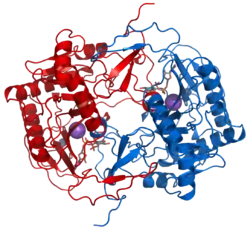Protein dimer
In biochemistry, a protein dimer is a macromolecular complex formed by two protein monomers, or single proteins, which are usually non-covalently bound. Many macromolecules, such as proteins or nucleic acids, form dimers. The word dimer has roots meaning "two parts", di- + -mer. A protein dimer is a type of protein quaternary structure.

A protein homodimer is formed by two identical proteins. A protein heterodimer is formed by two different proteins.
Most protein dimers in biochemistry are not connected by covalent bonds. An example of a non-covalent heterodimer is the enzyme reverse transcriptase, which is composed of two different amino acid chains.[1] An exception is dimers that are linked by disulfide bridges such as the homodimeric protein NEMO.[2]
Some proteins contain specialized domains to ensure dimerization (dimerization domains) and specificity.[3]
Examples
- Transcription factors
- Leucine zipper motif proteins
- 14-3-3 proteins
- Variable surface glycoproteins of the Trypanosoma parasite
- Tubulin
- Some clotting factors
- Some receptors
- Some enzymes
Alkaline phosphatase
E. coli alkaline phosphatase, a dimer enzyme, exhibits intragenic complementation.[4] That is, when particular mutant versions of alkaline phosphatase were combined, the heterodimeric enzymes formed as a result exhibited a higher level of activity than would be expected based on the relative activities of the parental enzymes. These findings indicated that the dimer structure of the E. coli alkaline phosphatase allows cooperative interactions between the constituent mutant monomers that can generate a more functional form of the holoenzyme.
See also
References
- Sluis-Cremer N, Hamamouch N, San Félix A, Velazquez S, Balzarini J, Camarasa MJ (August 2006). "Structure-activity relationships of [2',5'-bis-O-(tert-butyldimethylsilyl)-beta-D-ribofuranosyl]- 3'-spiro-5' '-(4' '-amino-1' ',2' '-oxathiole-2' ',2' '-dioxide)thymine derivatives as inhibitors of HIV-1 reverse transcriptase dimerization". J. Med. Chem. 49 (16): 4834–41. doi:10.1021/jm0604575. PMID 16884295.
- Herscovitch M, Comb W, Ennis T, Coleman K, Yong S, Armstead B, Kalaitzidis D, Chandani S, Gilmore TD (February 2008). "Intermolecular disulfide bond formation in the NEMO dimer requires Cys54 and Cys347". Biochemical and Biophysical Research Communications. 367 (1): 103–8. doi:10.1016/j.bbrc.2007.12.123. PMC 2277332. PMID 18164680.
- Amoutzias, Grigoris D.; Robertson, David L.; Van de Peer, Yves; Oliver, Stephen G. (2008-05-01). "Choose your partners: dimerization in eukaryotic transcription factors". Trends in Biochemical Sciences. 33 (5): 220–229. doi:10.1016/j.tibs.2008.02.002. ISSN 0968-0004. PMID 18406148.
- Hehir MJ, Murphy JE, Kantrowitz ER. Characterization of heterodimeric alkaline phosphatases from Escherichia coli: an investigation of intragenic complementation. J Mol Biol. 2000;304(4):645-656. doi:10.1006/jmbi.2000.4230